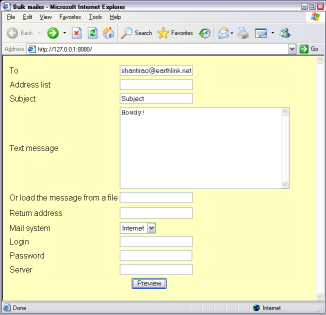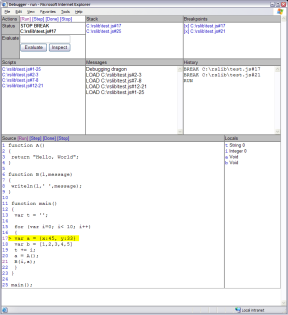from
http://json.org/example.html
It's basically just a list of name / value pairs encoded for Javascript. Pretty simple minded but it does the job
 |
JSON Example
|
{
"glossary": {
"title": "example glossary",
"GlossDiv": {
"title": "S",
"GlossList": {
"GlossEntry": {
"ID": "SGML",
"SortAs": "SGML",
"GlossTerm": "Standard Generalized Markup Language",
"Acronym": "SGML",
"Abbrev": "ISO 8879:1986",
"GlossDef": {
"para": "A meta-markup language, used to create markup languages such as DocBook.",
"GlossSeeAlso": ["GML", "XML"]
},
"GlossSee": "markup"
}
}
}
}
}
The same text expressed as
XML:
<!DOCTYPE glossary PUBLIC "-//OASIS//DTD DocBook V3.1//EN">
<glossary><title>example glossary</title>
<GlossDiv><title>S</title>
<GlossList>
<GlossEntry ID="SGML" SortAs="SGML">
<GlossTerm>Standard Generalized Markup Language</GlossTerm>
<Acronym>SGML</Acronym>
<Abbrev>ISO 8879:1986</Abbrev>
<GlossDef>
<para>A meta-markup language, used to create markup
languages such as DocBook.</para>
<GlossSeeAlso OtherTerm="GML">
<GlossSeeAlso OtherTerm="XML">
</GlossDef>
<GlossSee OtherTerm="markup">
</GlossEntry>
</GlossList>
</GlossDiv>
</glossary>
{"menu": {
"id": "file",
"value": "File",
"popup": {
"menuitem": [
{"value": "New", "onclick": "CreateNewDoc()"},
{"value": "Open", "onclick": "OpenDoc()"},
{"value": "Close", "onclick": "CloseDoc()"}
]
}
}}
The same text expressed as
XML:
<menu id="file" value="File">
<popup>
<menuitem value="New" onclick="CreateNewDoc()" />
<menuitem value="Open" onclick="OpenDoc()" />
<menuitem value="Close" onclick="CloseDoc()" />
</popup>
</menu>
{"widget": {
"debug": "on",
"window": {
"title": "Sample Konfabulator Widget",
"name": "main_window",
"width": 500,
"height": 500
},
"image": {
"src": "Images/Sun.png",
"name": "sun1",
"hOffset": 250,
"vOffset": 250,
"alignment": "center"
},
"text": {
"data": "Click Here",
"size": 36,
"style": "bold",
"name": "text1",
"hOffset": 250,
"vOffset": 100,
"alignment": "center",
"onMouseUp": "sun1.opacity = (sun1.opacity / 100) * 90;"
}
}}
The same text expressed as
XML:
<widget>
<debug>on</debug>
<window title="Sample Konfabulator Widget">
<name>main_window</name>
<width>500</width>
<height>500</height>
</window>
<image src="Images/Sun.png" name="sun1">
<hOffset>250</hOffset>
<vOffset>250</vOffset>
<alignment>center</alignment>
</image>
<text data="Click Here" size="36" style="bold">
<name>text1</name>
<hOffset>250</hOffset>
<vOffset>100</vOffset>
<alignment>center</alignment>
<onMouseUp>
sun1.opacity = (sun1.opacity / 100) * 90;
</onMouseUp>
</text>
</widget>
{"web-app": {
"servlet": [
{
"servlet-name": "cofaxCDS",
"servlet-class": "org.cofax.cds.CDSServlet",
"init-param": {
"configGlossary:installationAt": "Philadelphia, PA",
"configGlossary:adminEmail": "ksm@pobox.com",
"configGlossary:poweredBy": "Cofax",
"configGlossary:poweredByIcon": "/images/cofax.gif",
"configGlossary:staticPath": "/content/static",
"templateProcessorClass": "org.cofax.WysiwygTemplate",
"templateLoaderClass": "org.cofax.FilesTemplateLoader",
"templatePath": "templates",
"templateOverridePath": "",
"defaultListTemplate": "listTemplate.htm",
"defaultFileTemplate": "articleTemplate.htm",
"useJSP": false,
"jspListTemplate": "listTemplate.jsp",
"jspFileTemplate": "articleTemplate.jsp",
"cachePackageTagsTrack": 200,
"cachePackageTagsStore": 200,
"cachePackageTagsRefresh": 60,
"cacheTemplatesTrack": 100,
"cacheTemplatesStore": 50,
"cacheTemplatesRefresh": 15,
"cachePagesTrack": 200,
"cachePagesStore": 100,
"cachePagesRefresh": 10,
"cachePagesDirtyRead": 10,
"searchEngineListTemplate": "forSearchEnginesList.htm",
"searchEngineFileTemplate": "forSearchEngines.htm",
"searchEngineRobotsDb": "WEB-INF/robots.db",
"useDataStore": true,
"dataStoreClass": "org.cofax.SqlDataStore",
"redirectionClass": "org.cofax.SqlRedirection",
"dataStoreName": "cofax",
"dataStoreDriver": "com.microsoft.jdbc.sqlserver.SQLServerDriver",
"dataStoreUrl": "jdbc:microsoft:sqlserver://LOCALHOST:1433;DatabaseName=goon",
"dataStoreUser": "sa",
"dataStorePassword": "dataStoreTestQuery",
"dataStoreTestQuery": "SET NOCOUNT ON;select test='test';",
"dataStoreLogFile": "/usr/local/tomcat/logs/datastore.log",
"dataStoreInitConns": 10,
"dataStoreMaxConns": 100,
"dataStoreConnUsageLimit": 100,
"dataStoreLogLevel": "debug",
"maxUrlLength": 500}},
{
"servlet-name": "cofaxEmail",
"servlet-class": "org.cofax.cds.EmailServlet",
"init-param": {
"mailHost": "mail1",
"mailHostOverride": "mail2"}},
{
"servlet-name": "cofaxAdmin",
"servlet-class": "org.cofax.cds.AdminServlet"},
{
"servlet-name": "fileServlet",
"servlet-class": "org.cofax.cds.FileServlet"},
{
"servlet-name": "cofaxTools",
"servlet-class": "org.cofax.cms.CofaxToolsServlet",
"init-param": {
"templatePath": "toolstemplates/",
"log": 1,
"logLocation": "/usr/local/tomcat/logs/CofaxTools.log",
"logMaxSize": "",
"dataLog": 1,
"dataLogLocation": "/usr/local/tomcat/logs/dataLog.log",
"dataLogMaxSize": "",
"removePageCache": "/content/admin/remove?cache=pages&id=",
"removeTemplateCache": "/content/admin/remove?cache=templates&id=",
"fileTransferFolder": "/usr/local/tomcat/webapps/content/fileTransferFolder",
"lookInContext": 1,
"adminGroupID": 4,
"betaServer": true}}],
"servlet-mapping": {
"cofaxCDS": "/",
"cofaxEmail": "/cofaxutil/aemail/*",
"cofaxAdmin": "/admin/*",
"fileServlet": "/static/*",
"cofaxTools": "/tools/*"},
"taglib": {
"taglib-uri": "cofax.tld",
"taglib-location": "/WEB-INF/tlds/cofax.tld"}}}
The same file expressed as
XML:
<?xml version="1.0" encoding="ISO-8859-1"?>
<!DOCTYPE web-app
PUBLIC "-//Sun Microsystems, Inc.//DTD Web Application 2.2//EN"
"http://java.sun.com/j2ee/dtds/web-app_2.2.dtd">
<web-app>
<servlet>
<servlet-name>
cofaxCDS
</servlet-name>
<servlet-class>
org.cofax.cds.CDSServlet
</servlet-class>
<init-param>
<param-name>configGlossary:installationAt</param-name>
<param-value>Philadelphia, PA</param-value>
</init-param>
<init-param>
<param-name>configGlossary:adminEmail</param-name>
<param-value>ksm@pobox.com</param-value>
</init-param>
<init-param>
<param-name>configGlossary:poweredBy</param-name>
<param-value>Cofax</param-value>
</init-param>
<init-param>
<param-name>configGlossary:poweredByIcon</param-name>
<param-value>/images/cofax.gif</param-value>
</init-param>
<init-param>
<param-name>configGlossary:staticPath</param-name>
<param-value>/content/static</param-value>
</init-param>
<init-param>
<param-name>templateProcessorClass</param-name>
<param-value>org.cofax.WysiwygTemplate</param-value>
</init-param>
<init-param>
<param-name>templateLoaderClass</param-name>
<param-value>org.cofax.FilesTemplateLoader</param-value>
</init-param>
<init-param>
<param-name>templatePath</param-name>
<param-value>templates</param-value>
</init-param>
<init-param>
<param-name>templateOverridePath</param-name>
<param-value></param-value>
</init-param>
<init-param>
<param-name>defaultListTemplate</param-name>
<param-value>listTemplate.htm</param-value>
</init-param>
<init-param>
<param-name>defaultFileTemplate</param-name>
<param-value>articleTemplate.htm</param-value>
</init-param>
<init-param>
<param-name>useJSP</param-name>
<param-value>false</param-value>
</init-param>
<init-param>
<param-name>jspListTemplate</param-name>
<param-value>listTemplate.jsp</param-value>
</init-param>
<init-param>
<param-name>jspFileTemplate</param-name>
<param-value>articleTemplate.jsp</param-value>
</init-param>
<init-param>
<param-name>cachePackageTagsTrack</param-name>
<param-value>200</param-value>
</init-param>
<init-param>
<param-name>cachePackageTagsStore</param-name>
<param-value>200</param-value>
</init-param>
<init-param>
<param-name>cachePackageTagsRefresh</param-name>
<param-value>60</param-value>
</init-param>
<init-param>
<param-name>cacheTemplatesTrack</param-name>
<param-value>100</param-value>
</init-param>
<init-param>
<param-name>cacheTemplatesStore</param-name>
<param-value>50</param-value>
</init-param>
<init-param>
<param-name>cacheTemplatesRefresh</param-name>
<param-value>15</param-value>
</init-param>
<init-param>
<param-name>cachePagesTrack</param-name>
<param-value>200</param-value>
</init-param>
<init-param>
<param-name>cachePagesStore</param-name>
<param-value>100</param-value>
</init-param>
<init-param>
<param-name>cachePagesRefresh</param-name>
<param-value>10</param-value>
</init-param>
<init-param>
<param-name>cachePagesDirtyRead</param-name>
<param-value>10</param-value>
</init-param>
<init-param>
<param-name>searchEngineListTemplate</param-name>
<param-value>forSearchEnginesList.htm</param-value>
</init-param>
<init-param>
<param-name>searchEngineFileTemplate</param-name>
<param-value>forSearchEngines.htm</param-value>
</init-param>
<init-param>
<param-name>searchEngineRobotsDb</param-name>
<param-value>WEB-INF/robots.db</param-value>
</init-param>
<init-param>
<param-name>useDataStore</param-name>
<param-value>true</param-value>
</init-param>
<init-param>
<param-name>dataStoreClass</param-name>
<param-value>org.cofax.SqlDataStore</param-value>
</init-param>
<init-param>
<param-name>redirectionClass</param-name>
<param-value>org.cofax.SqlRedirection</param-value>
</init-param>
<init-param>
<param-name>dataStoreName</param-name>
<param-value>cofax</param-value>
</init-param>
<init-param>
<param-name>dataStoreDriver</param-name>
<param-value>com.microsoft.jdbc.sqlserver.SQLServerDriver</param-value>
</init-param>
<init-param>
<param-name>dataStoreUrl</param-name>
<param-value>jdbc:microsoft:sqlserver://LOCALHOST:1433;DatabaseName=goon</param-value>
</init-param>
<init-param>
<param-name>dataStoreUser</param-name>
<param-value>sa</param-value>
</init-param>
<init-param>
<param-name>dataStorePassword</param-name>
<param-value></param-value>
</init-param>
<init-param>
<param-name>dataStoreTestQuery</param-name>
<param-value>SET NOCOUNT ON;select test='test';</param-value>
</init-param>
<init-param>
<param-name>dataStoreLogFile</param-name>
<param-value>/usr/local/tomcat/logs/datastore.log</param-value>
</init-param>
<init-param>
<param-name>dataStoreInitConns</param-name>
<param-value>10</param-value>
</init-param>
<init-param>
<param-name>dataStoreMaxConns</param-name>
<param-value>100</param-value>
</init-param>
<init-param>
<param-name>dataStoreConnUsageLimit</param-name>
<param-value>100</param-value>
</init-param>
<init-param>
<param-name>dataStoreLogLevel</param-name>
<param-value>debug</param-value>
</init-param>
<init-param>
<param-name>maxUrlLength</param-name>
<param-value>500</param-value>
</init-param>
</servlet>
<servlet>
<servlet-name>
cofaxEmail
</servlet-name>
<servlet-class>
org.cofax.cds.EmailServlet
</servlet-class>
<init-param>
<param-name>mailHost</param-name>
<param-value>mail1</param-value>
</init-param>
<init-param>
<param-name>mailHostOverride</param-name>
<param-value>mail2</param-value>
</init-param>
</servlet>
<servlet>
<servlet-name>
cofaxAdmin
</servlet-name>
<servlet-class>
org.cofax.cds.AdminServlet
</servlet-class>
</servlet>
<servlet>
<servlet-name>
fileServlet
</servlet-name>
<servlet-class>
org.cofax.cds.FileServlet
</servlet-class>
</servlet>
<servlet>
<servlet-name>
cofaxTools
</servlet-name>
<servlet-class>
org.cofax.cms.CofaxToolsServlet
</servlet-class>
<init-param>
<param-name>templatePath</param-name>
<param-value>toolstemplates/</param-value>
</init-param>
<init-param>
<param-name>log</param-name>
<param-value>1</param-value>
</init-param>
<init-param>
<param-name>logLocation</param-name>
<param-value>/usr/local/tomcat/logs/CofaxTools.log</param-value>
</init-param>
<init-param>
<param-name>logMaxSize</param-name>
<param-value></param-value>
</init-param>
<init-param>
<param-name>dataLog</param-name>
<param-value>1</param-value>
</init-param>
<init-param>
<param-name>dataLogLocation</param-name>
<param-value>/usr/local/tomcat/logs/dataLog.log</param-value>
</init-param>
<init-param>
<param-name>dataLogMaxSize</param-name>
<param-value></param-value>
</init-param>
<init-param>
<param-name>removePageCache</param-name>
<param-value>/content/admin/remove?cache=pages&id=</param-value>
</init-param>
<init-param>
<param-name>removeTemplateCache</param-name>
<param-value>/content/admin/remove?cache=templates&id=</param-value>
</init-param>
<init-param>
<param-name>fileTransferFolder</param-name>
<param-value>/usr/local/tomcat/webapps/content/fileTransferFolder</param-value>
</init-param>
<init-param>
<param-name>lookInContext</param-name>
<param-value>1</param-value>
</init-param>
<init-param>
<param-name>adminGroupID</param-name>
<param-value>4</param-value>
</init-param>
<init-param>
<param-name>betaServer</param-name>
<param-value>true</param-value>
</init-param>
</servlet>
<servlet-mapping>
<servlet-name>
cofaxCDS
</servlet-name>
<url-pattern>
/
</url-pattern>
</servlet-mapping>
<servlet-mapping>
<servlet-name>
cofaxEmail
</servlet-name>
<url-pattern>
/cofaxutil/aemail/*
</url-pattern>
</servlet-mapping>
<servlet-mapping>
<servlet-name>
cofaxAdmin
</servlet-name>
<url-pattern>
/admin/*
</url-pattern>
</servlet-mapping>
<servlet-mapping>
<servlet-name>
fileServlet
</servlet-name>
<url-pattern>
/static/*
</url-pattern>
</servlet-mapping>
<servlet-mapping>
<servlet-name>
cofaxTools
</servlet-name>
<url-pattern>
/tools/*
</url-pattern>
</servlet-mapping>
<taglib>
<taglib-uri>cofax.tld</taglib-uri>
<taglib-location>/WEB-INF/tlds/cofax.tld</taglib-location>
</taglib>
</web-app>
The action and label values only need to be provided if they are not the same as the id.
{"menu": {
"header": "SVG Viewer",
"items": [
{"id": "Open"},
{"id": "OpenNew", "label": "Open New"},
null,
{"id": "ZoomIn", "label": "Zoom In"},
{"id": "ZoomOut", "label": "Zoom Out"},
{"id": "OriginalView", "label": "Original View"},
null,
{"id": "Quality"},
{"id": "Pause"},
{"id": "Mute"},
null,
{"id": "Find", "label": "Find..."},
{"id": "FindAgain", "label": "Find Again"},
{"id": "Copy"},
{"id": "CopyAgain", "label": "Copy Again"},
{"id": "CopySVG", "label": "Copy SVG"},
{"id": "ViewSVG", "label": "View SVG"},
{"id": "ViewSource", "label": "View Source"},
{"id": "SaveAs", "label": "Save As"},
null,
{"id": "Help"},
{"id": "About", "label": "About Adobe CVG Viewer..."}
]
}}
The same message expressed as
XML:
<menu>
<header>Adobe SVG Viewer</header>
<item action="Open" id="Open">Open</item>
<item action="OpenNew" id="OpenNew">Open New</item>
<separator/>
<item action="ZoomIn" id="ZoomIn">Zoom In</item>
<item action="ZoomOut" id="ZoomOut">Zoom Out</item>
<item action="OriginalView" id="OriginalView">Original View</item>
<separator/>
<item action="Quality" id="Quality">Quality</item>
<item action="Pause" id="Pause">Pause</item>
<item action="Mute" id="Mute">Mute</item>
<separator/>
<item action="Find" id="Find">Find...</item>
<item action="FindAgain" id="FindAgain">Find Again</item>
<item action="Copy" id="Copy">Copy</item>
<item action="CopyAgain" id="CopyAgain">Copy Again</item>
<item action="CopySVG" id="CopySVG">Copy SVG</item>
<item action="ViewSVG" id="ViewSVG">View SVG</item>
<item action="ViewSource" id="ViewSource">View Source</item>
<item action="SaveAs" id="SaveAs">Save As</item>
<separator/>
<item action="Help" id="Help">Help</item>
<item action="About" id="About">About Adobe CVG Viewer...</item>
</menu>









